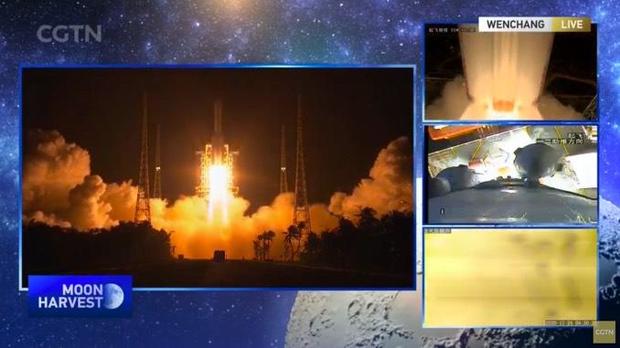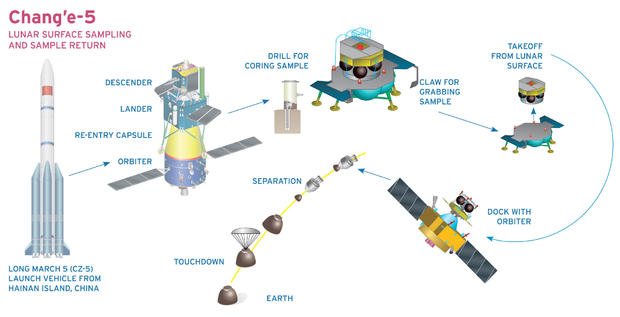China launches ambitious mission to land on moon and return samples to Earth
China launched its most ambitious moon mission yet Monday: a robotic spacecraft expected to land on the lunar surface by the end of the week. The spacecraft is expected to collect about 4 pounds of rock and soil samples, and return them to Earth next month for laboratory analysis.
If successful, the Chang'e 5 mission will make China only the third nation, after the United States and the former Soviet Union, to bring moon rocks back to Earth. It will also be the first to attempt the feat since Russia's Luna 24 in 1976.
"China is showing itself capable of developing and successfully carrying out sustained high-tech programs, important for regional influence and potentially global partnerships," Joan Johnson-Freese, a space expert at the U.S. Naval War College, told The Associated Press.
Building on the success of two robotic moon rovers, a powerful Long March 5 rocket thundered to life at 3:30 p.m. ET — 4:30 a.m. Tuesday local time — and climbed away from the Wenchang Satellite Launch Center on Hainan Island in the South China Sea.
Televised live, the heavy-lift rocket put on a spectacular predawn show as it arced away to the east and streaked into space.
The 8,335-pound Chang'e 5 spacecraft, named after the mythical Chinese goddess of the moon, is made up of four major components: a lunar orbiter, a sample return craft, a lander carrying science instruments and sample collection equipment, and a small ascent vehicle mounted atop the lander to carry the collected surface samples back up to orbit.
If all goes well, the solar-powered lander will descend to the moon's surface on Friday as 14 days of sunlight break across a 43-mile-wide volcanic mound known as Mons Rümkerof in the Ocean of Storms.
Rocks and soil at the landing site are expected to date back about 1.1 billion years, much younger than the rocks collected by the Apollo astronauts, according to The Planetary Society.
"China is doing a great job here in terms of their first sample return mission," James Head, a geologist at Brown University, told China's CCTV. "We haven't been returning samples for 44 years, and we have many scientific questions which the Chang'e 5 mission is going to help us answer."
"This is really exciting opportunity, and we really appreciate China's efforts in this area," Head added.
The Chang'e 5 lander features multiple cameras, a spectrometer to assess the composition of the soil near the spacecraft and a ground-penetrating radar. A robot arm is equipped with a percussive drill and scoop to pick up excavated rock and soil.
Working by remote control from Earth, engineers will use the arm to move collected samples up to the ascent vehicle, which then will blast off, rendezvous with the Chang'e 5 orbiter and transfer the sample to the return craft for the trip back to Earth.
Landing in Inner Mongolia is expected around December 16. From there, the samples will be transferred to specially equipped laboratories for analysis.
China's lunar exploration program began with the Chang'e 1 and 2 missions, which successfully reached lunar orbit in 2007 and 2010 respectively. Those flights were followed by the Chang'e 3 lunar lander in 2013 and by Chang'e 4, which landed on the far side of the moon in 2019.
Two sample return missions are planned before possible missions to land Chinese astronauts on the surface in the 2030s.
"China works very incrementally, developing building blocks for long-term use for a variety of missions," Freese-Johnson said, adding that the country's one-party system allows "prolonged political will that is often difficult in democracies."
In the meantime, NASA is pressing ahead with its Artemis program, which aims to land the next man and the first woman on the moon in the next several years. How that program, supported by the Trump administration, will fare under a Biden administration is not yet known.







